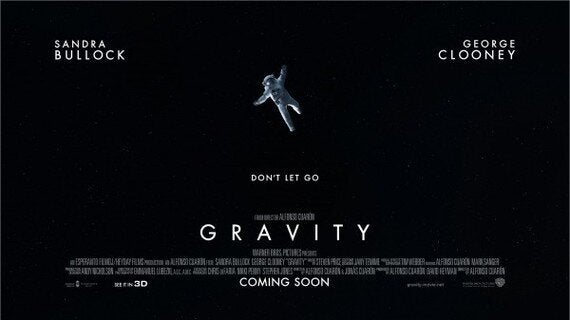
(Picture: Gravity teaser poster. 2013)
"Lowry ... stood across the road from his subjects and observed. Often enough there are a number of individuals in a crowd peering back at him. They invite us momentarily into their world, like characters on a stage sometimes do, breaking the fourth-wall illusion."
'Sir Ian McKellen: My lifelong passion for LS Lowry'
The Telegraph. 21 April 2011
Breaking the fourth wall is always a bold decision. To explicitly acknowledge the audience is to deliberately break the illusion, an act as liable to pull an audience out of the moment as draw them conspiratorially in.
It worked for Alfie, it worked for Ferris Bueller, and considering Sir Ian McKellen's remarks, it worked rather well for Northern artist LS Lowry.
Of course, art and movies and story-telling at their best have always used their magic to invite audiences into their world.
When Alice stepped through the looking glass, she broke through the fourth wall, crossed the divide and entered a land different to her own. This is why we love books and movies and plays. Because we are transported. We are exposed to a place other than our own. We become someone other than who we are, potentially are provoked into experiencing a set of feelings that are far from commonplace. And as you read this (yes, that was me breaking the fourth wall) you may fairly think, "This is all true but nothing new."
Where novelty always returns to the fray is when technological progress marries with creative vision, allowing story-tellers to keep challenging "the imaginary boundary between any fictional work and its audience." (Wikpedia)
Consider Irmin Roberts' reverse (dolly) zoom in Vertigo (1958) and Spielberg's genius-stealing of it for Jaws (1975), in both cases evoking for audiences that "falling-away-from-oneself feeling".
Consider the way Steadicam inventor Garret Brown tracked Danny's Big Wheel tricycle tours through the hallways of the Overlook Hotel. Kubrick acknowledged the invaluable contribution Brown made to The Shining, using the Steadicam "as it was intended to be used - as a tool which can help get the lens where it's wanted in space and time without the classic limitations".
Consider the genius of Welles, Altman and De Palma and where they respectively placed their lenses to create the opening tracking shots for Touch of Evil (3 mins 20), The Player (8 mins 5) and Bonfire of the Vanities (4 mins 50).
Movies have always provided escapism, for audiences the suspension of everyday proceedings, where we suddenly stop disbelieving, forget who we are, and begin to vicariously experience something else.
In 1978, the marketing of Richard Donner's Superman promised, "You'll believe a man can fly". In 2013, Zach Snyder's Man of Steel treated us to Superman-cam, of not just watching a 21st C-GI Superman, but being part of scenes as if we could fly as him.
As 'The Audience' we have always inclined to step (like Alice) through the fourth wall and project ourselves into the scene - and the latest film-making technologies are making that natural inclination a more immersive, deeply felt experience. The success of Gravity, and particularly the success of the Gravity trailers, provide perfect illustration.
Gravity's official trailer is close to 11m views on YouTube. It was the highest viewed trailer of all the movies nominated for an Oscar in 2013. Warner Bros produced a total of 41 official videos for the film, generating over 26m views. In consequence they have also re-written the rules for the role of promotional content in a movie's marketing mix - because the trailers weren't just serving to tease. They weren't merely keyhole views of the main event - but visual spectacles in their own right. The official trailer is a 2 min 20 sensation of the very proposition that would have got Gravity green lit in the first place. Just imagine being lost in space, not in the "Danger Will Robinson" sense, but in the trapped in a vacuum, the ultimate bigness of nothing creating the most absolute sense of claustrophobia and despair? You get that experience from the trailer.
'The Trailer' has the potential to become an 'event' on its own merit, to be content that works standalone in its ability to mesmerize and hypnotize.
In the 'All About Me' age of social media documentation, first person chronicling and Go Pro capturing, Gravity's trailer is the perfect content fix. Tellingly, the theatrical poster for Gravity also eschewed famous face exhibiting conventions. Like the image of Jaws ascending on an unsuspecting swimmer, Gravity's poster shows its own 'ultimate oh-no moment', the image of a space man, safety line suddenly broken.
Gravity further evidences that it is a fascinating time for the marketing of movies, and indeed, for movie-making.
Second-generation 3-D is more effectively immersing audiences within 'The Moment'. 3-D is at last evolving from the gimmickry of shooting arrows at us. With Avatar, Cameron created a very green and vividly rendered world, which started the 3-D ball rolling once again. Certain scenes in Prometheus were better for being seen with depth perception, the technology evoking a viewing experience that paralleled that felt by the characters. And then Alfonso Cuarón came along and changed the game again.
Whether watching Gravity in 2D or 3D, the experience is captivating, dizzying, disorienting, 'The Audience' afforded 91 minutes of what it must feel like to attend space camp, and then have disaster strike. (Cuarón described his opening tracking shot as "a pain in the ass" - but then, maybe all great art is?
I suspect Gravity might just be the dawning sun of a new genre in movie-making: the 'super-immersive' movie concept. It will influence the movies that get produced and how they are later marketed.
While there has always been a connecting thread, a kind of umbilical cord between screen and audience, in where the lens is so remarkably placed, Gravity newly considers 'the viewing sensation'. Cuarón is re-acknowledging that all the world really is a stage, upon which we have concurrent roles, where we serve as both audience and look to fashion ourselves as protagonist.
The Best Director Oscar is gloriously deserving for a movie (and movie concept) that sucks us through the fourth wall and into the illusion of story and space. While we know that we'll make it out of the movie theatre, our empathy with Sandra Bullock is such that there are moments when we feel it could be touch and go.
Watching Gravity isn't life threatening, but to steal a line from Robert Redford at the end of The Sting, a tale of illusion and deception, "it sure is close".
SP.
